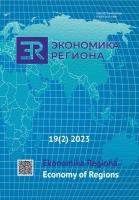Социально-экономические детерминанты потребления табачной продукции в регионах России
Socio-Economic Determinants of Tobacco Consumption in Russian Regions
Author(s): Svetlana Victorovna Doroshenko, Olga V. SanaevaSubject(s): Economy, Micro-Economics, Socio-Economic Research
Published by: Институт экономики Уральского отделения Российской академии наук
Keywords: Russian regions; tobacco; factors; education; debt; unemployment; income; alcohol; divorce; quantile regression;
Summary/Abstract: Nowadays, it is necessary to analyse the influence of various socio-economic factors on the regional heterogeneity of tobacco consumption in Russia, since there is a lack of econometric studies based on regional data. The present study aims to assess the impact of financial, economic and educational factors on tobacco consumption in Russian regions. To this end, a simultaneous quantile regression approach, resistant to outliers, was applied to separately estimate the influence of the above factors on regions classified as light and heavy smokers. Panel data on 82 Russian regions for the period 2005-2019 was examined. The dependent variable is the percentage of household expenditures on tobacco obtained from a sample survey of household budgets. The main independent variables are education, income, unemployment, loan debt. Control variables include alcohol consumption, male-to-female ratio, divorce rate, proportion of the rural population, binary variables. The invariance of the impact of factors relative to the percentiles of regions was revealed. The greatest differences are observed between light and heavy smokers regions (q10 and q90 groups). Individual loan debts, average per capita income, alcohol consumption, increase in excise tax, divorces and emergence of e-cigarettes are significant for regions with low tobacco consumption and insignificant for regions with high consumption. High consumption regions are greatly influenced by the male-to-female ratio, number of graduates of secondary vocational institutions and proportion of the rural population. Such factors as higher education, crises and anti-tobacco laws are significant for each quintile. The results can be used to improve state policy measures to reduce the consumption of nicotine products. The study is limited by the lack of regional data in terms of age and gender.
Journal: Экономика региона
- Issue Year: 19/2023
- Issue No: 2
- Page Range: 370-384
- Page Count: 15
- Language: Russian

